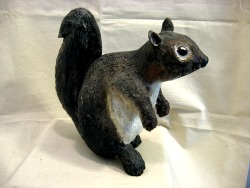Jules Lafontaine. Sculptor. Quebec. Active late 20th century.
Jules Lafontaine is a carver of dioramas.
Canadian Folk Art and Outsider Art
Jules Lafontaine. Sculptor. Quebec. Active late 20th century.
Jules Lafontaine is a carver of dioramas.
Henri Dube. Sculptor. Saint-Louis-de-Ha-Ha, Quebec. Active early 20th century.
A carved and painted Crucifix by Henri Dube:
Henri Laviolette. Wood carver. Sculptor. Valleyfield, Quebec. Active early 20th century.
Henri Laviolette was a decoy carver. His work is widely collected.
Alcide Saint-Germain. Sculptor. Saint-Antoine-Abbe, Quebec. Active mid 20th century.
Maker of primitive wood carvings that filled his yard in the village of Saint-Antoine-Abbe. Much of his work has many coats of paint as he would over-paint them as they became worn by the weather. He would also fill cracks and patch holes as they developed, using cement, plaster or whatever came to hand. M. Saint-Germain made carvings of every size; including Giraffes that loomed up over the out buildings as you drove up the road. There were birds in flight hanging wherever there was space for them. He fortunately lived long enough to see his work recognized in an exhibit at the McCord museum in Montreal. Alcide Saint-Germain was an artist; his inspiration was the world; and his art was his reaction to it. Alcide Saint Germain never signed his work.
A link to Civilization.ca with a work by Alcide Saint-Germain. One of his favorite subjects: The Panguin:
http://www.historymuseum.ca/cmc/exhibitions/arts/eden/edout01e.shtml
Elphege Valois. Sculptor. Causapscal, Quebec. (B. Roxton Falls.) Active mid 20th century.
A prolific and varied artist; Elphege Valois filled his world (and his back yard) with his carvings of people, animals and birds. He often worked with ‘as found’ materials; particularly in his yard carvings. Elphage Valois is known for his carvings of Horses and Horse drawn vehicles as well for his sometimes stunning carvings of people especially in the form of carved heads. He usually finished his carvings with with varnish and ‘as found’ house paints. He signed his carvings: ‘J.E. Valois’ using a wood-burning tool.
His carvings of smiling heads are exceptionally fine examples of Quebec naive and outsider art. In an interview the artist said that he ‘liked to make wood laugh’, and that he achieved this by putting teeth (in white plastic) in his carved heads.
A Carved Sulky and Driver by Elphege Valois:
Another example of one of his horse-drawn carriages (A ‘Vis-a-Vis’) in The Museum of Civilization:
http://www.historymuseum.ca/cmc/exhibitions/tresors/treasure/209eng.shtml
Ref: Canadian Centre for Folk Culture Studies of the National Museum of Man, From the Heart: Folk Art in Canada, Toronto: McClelland and Stewart, c1983,
Ref: Les Patenteux du Qubec. Louise de Grosbois, Raymonde Lamothe and Lise Nantel, Les Editions Parti Pris, Montreal, 1978.


This work is licensed under a Creative Commons Attribution 3.0 Unported License. · LyleElderFolkArt.com · Site by padroneMedia